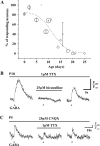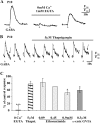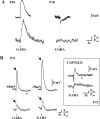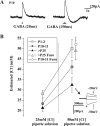Differential maturation of GABA action and anion reversal potential in spinal lamina I neurons: impact of chloride extrusion capacity
- PMID: 16237166
- PMCID: PMC6725724
- DOI: 10.1523/JNEUROSCI.1488-05.2005
Differential maturation of GABA action and anion reversal potential in spinal lamina I neurons: impact of chloride extrusion capacity
Erratum in
- J Neurosci. 2005 Nov 9;25(45):10574-5
Abstract
A deficit in inhibition in the spinal dorsal horn has been proposed to be an underlying cause of the exaggerated cutaneous sensory reflexes observed in newborn rats. However, the developmental shift in transmembrane anion gradient, potentially affecting the outcome of GABAA transmission, was shown to be completed within 1 week after birth in the spinal cord, an apparent disparity with the observation that reflex hypersensitivity persists throughout the first 2-3 postnatal weeks. To further investigate this issue, we used several approaches to assess the action of GABA throughout development in spinal lamina I (LI) neurons. GABA induced an entry of extracellular calcium in LI neurons from postnatal day 0 (P0) to P21 rats, which involved T- and N-type voltage-gated calcium channels. Gramicidin perforated-patch recordings revealed that the shift in anion gradient was completed by P7 in LI neurons. However, high chloride pipette recordings demonstrated that these neurons had not reached their adult chloride extrusion capacity by P10-P11. Simultaneous patch-clamp recordings and calcium imaging revealed that biphasic responses to GABA, consisting of a primary hyperpolarization followed by a rebound depolarization, produced a rise in [Ca2+]i. Thus, even if Eanion predicts GABAA-induced hyperpolarization from rest, a low chloride extrusion capacity can cause a rebound depolarization and an ensuing rise in [Ca2+]i. We demonstrate that GABA action in LI neurons matures throughout the first 3 postnatal weeks, therefore matching the time course of maturation of withdrawal reflexes. Immature spinal GABA signaling may thus contribute to the nociceptive hypersensitivity in infant rats.
Figures







Similar articles
-
Development of GABAergic and glycinergic transmission in the neonatal rat dorsal horn.J Neurosci. 2004 May 19;24(20):4749-57. doi: 10.1523/JNEUROSCI.5211-03.2004. J Neurosci. 2004. PMID: 15152035 Free PMC article.
-
Functional GABA(A)-receptor-mediated inhibition in the neonatal dorsal horn.J Neurophysiol. 2006 Jun;95(6):3893-7. doi: 10.1152/jn.00123.2006. Epub 2006 May 10. J Neurophysiol. 2006. PMID: 16687622
-
Spinal cord injury-induced attenuation of GABAergic inhibition in spinal dorsal horn circuits is associated with down-regulation of the chloride transporter KCC2 in rat.J Physiol. 2008 Dec 1;586(23):5701-15. doi: 10.1113/jphysiol.2008.152348. Epub 2008 Oct 9. J Physiol. 2008. PMID: 18845615 Free PMC article.
-
Post-episode depression of GABAergic transmission in spinal neurons of the chick embryo.J Neurophysiol. 2001 May;85(5):2166-76. doi: 10.1152/jn.2001.85.5.2166. J Neurophysiol. 2001. PMID: 11353031
-
Chloride - The Underrated Ion in Nociceptors.Front Neurosci. 2020 Apr 8;14:287. doi: 10.3389/fnins.2020.00287. eCollection 2020. Front Neurosci. 2020. PMID: 32322187 Free PMC article. Review.
Cited by
-
Interleukin-1 receptor type 1 is overexpressed in neurons but not in glial cells within the rat superficial spinal dorsal horn in complete Freund adjuvant-induced inflammatory pain.J Neuroinflammation. 2017 Jun 23;14(1):125. doi: 10.1186/s12974-017-0902-x. J Neuroinflammation. 2017. PMID: 28645297 Free PMC article.
-
Aberrant synaptic integration in adult lamina I projection neurons following neonatal tissue damage.J Neurosci. 2015 Feb 11;35(6):2438-51. doi: 10.1523/JNEUROSCI.3585-14.2015. J Neurosci. 2015. PMID: 25673839 Free PMC article.
-
Functional Organization of Cutaneous and Muscle Afferent Synapses onto Immature Spinal Lamina I Projection Neurons.J Neurosci. 2017 Feb 8;37(6):1505-1517. doi: 10.1523/JNEUROSCI.3164-16.2016. Epub 2017 Jan 9. J Neurosci. 2017. PMID: 28069928 Free PMC article.
-
Low-threshold primary afferent drive onto GABAergic interneurons in the superficial dorsal horn of the mouse.J Neurosci. 2009 Jan 21;29(3):686-95. doi: 10.1523/JNEUROSCI.5120-08.2009. J Neurosci. 2009. PMID: 19158295 Free PMC article.
-
Transcriptional profile of spinal dynorphin-lineage interneurons in the developing mouse.Pain. 2019 Oct;160(10):2380-2397. doi: 10.1097/j.pain.0000000000001636. Pain. 2019. PMID: 31166300 Free PMC article.
References
-
- Abe Y, Furukawa K, Itoyama Y, Akaike N (1994) Glycine response in acutely dissociated ventromedial hypothalamic neuron of the rat: new approach with gramicidin perforated patch-clamp technique. J Neurophysiol 72: 1530-1537. - PubMed
-
- Ben Ari Y (2002) Excitatory actions of GABA during development: the nature of the nurture. Nat Rev Neurosci 3: 728-739. - PubMed
Publication types
MeSH terms
Substances
LinkOut - more resources
Full Text Sources
Miscellaneous
